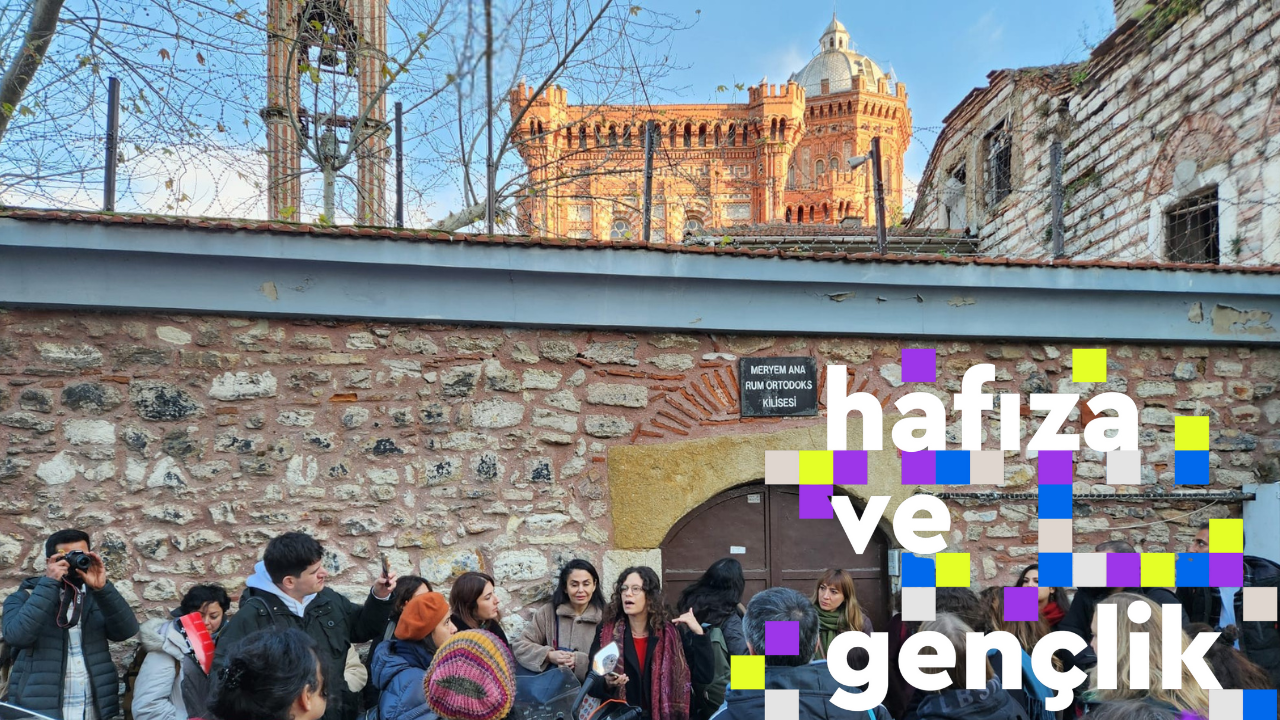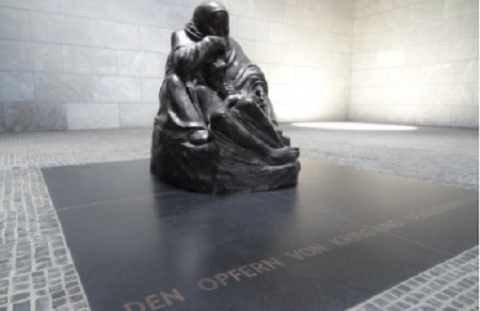
A Journey with Young People into Balat’s Multi-Layered Memory
On December 13–14, 2024, we organized an international conference titled “Confronting the Past, Building the Future: Memory Studies with Youth,” aiming to introduce a new dimension to efforts for coming to terms with the past and fostering a critical social memory by placing young people at the center of memory studies.
The conference concluded with a memory walk in Balat, attended by 45 participants. The route for this walk was shaped by the creative collaboration of four institutions and individuals. To determine some of the stops along the route, the Cultural and Social Narratives Laboratory’s (CSN Lab) “Balat: Living Together” projects and the Hrant Dink Foundation’s (HDV) “KarDes Multicultural Memory Tours” were utilized. Other stops were identified based on the walking experiences previously carried out in the area by the Karakutu Association and Sevcan Tiftik.
During the walk, Arsen Abrahamyan from CSN Lab, Sevcan Tiftik (one of the consultants for the Youth and Memory project), Damla Barın from HDV, and Umut Azak from Karakutu Association narrated the multilayered memory of the neighborhood, stop by stop. On the one hand, this walk shined a light on the urbanization and gentrification processes along the Fener-Balat-Ayvansaray axis; on the other, it drew attention to the personal memories of local residents, the history of migration, social transformations, and forgotten stories.

1. Stop: Fener Greek Boys’ High School & Usturumca Street
Our memory walk began with Sevcan Tiftik’s autoethnographic approach. Tiftik first spoke about the neighborhood’s urban transformation and gentrification projects, reminding participants of the area’s recent past. She then headed toward Tevkii Cafer Mektebi Çıkmazı, adjacent to the Fener Greek Boys’ High School. Here, Tiftik—who spent her childhood in Balat in the 1990s—explained how children of different ethnic and religious backgrounds played together among the ruins, creating a cultural exchange environment that transcended class, religion, and identity distinctions. Despite the fact that Kurban and Easter, as well as Ramadan and Christmas, were celebrated at different times, these rituals were rarely discussed in the neighborhood; nevertheless, the daily life and neighborly relations held great diversity.
Tiftik also shared overlapping traces of her own childhood through photographs of Ustrumca Street and Tevkii Cafer Mektebi Street taken by the painter and photographer Elenora Arhelaou (1937–2021), originally from Fener. For Tiftik, the neighborhood captured through Arhelaou’s lens still functioned as a vibrant site of memory. She described both the sense of loss evoked by structures that existed in the 1990s but have entirely disappeared today, and the preserved examples of houses, trees, and textures that remain as they were.
“This neighborhood, where Eleonora was born and where I spent my childhood, continues to live on within me, with its houses, trees, and traces that have remained untouched, allowing me to preserve the past. Yet the ruins from the ’90s, the occupied abandoned buildings, or the houses that existed in the ’90s but now stand before us in a completely different form—with no trace of their original walls or selves—are causing the erasure of the memories and traces of all identities who once lived here, including the Greeks.”
Sevcan Tiftik
2. Stop: Church of St. Mary of the Mongols
At the next stop, Damla Barın introduced the Church of St. Mary of the Mongols, also known as “Kanlı Meryem” (Bloody Mary). After Constantinople fell under Ottoman rule, nearly all domed churches in the city were converted into mosques, with the exception of St. Mary of the Mongols, which preserved its original function thanks to a special decree by Sultan Mehmed the Conqueror. A copy of this decree is displayed on the church wall.

Barın shared significant historical details of the church as well as the reason behind its nickname, “Kanlı Meryem.” According to a prevalent historical account, at the beginning of the 7th century, the daughter of a Byzantine emperor built a monastery on the city’s fifth hill. During the Latin Empire, established after the Fourth Crusade, this monastery was destroyed. When the Orthodox regained control of the city, the emperor, to guard against growing Mongol incursions in Anatolia, married off his daughter Maria to the Mongol emperor, sending her with a dowry. However, the Mongol emperor died before Maria arrived. Maria then returned to Constantinople and built this church. She dedicated herself to it, living in the adjoining monastery. Known as “Mary of the Mongols” (Maria Palailogos), her only surviving depiction can be seen in one of the church mosaics.
After the Ottoman conquest of Istanbul, fierce clashes took place in the area. Legend has it that the blood of the wounded in these battles around the church, located at the top of a steep slope, flowed down into the Golden Horn. The name “Kanlı Kilise” (Bloody Church) derives from this story.
3. Stop: Ahrida Synagogue
Upon arriving at the Ahrida Synagogue, Damla Barın discussed its significance to Balat’s Jewish community, the role of the Jewish congregation in Balat’s multicultural past, and the neighborhood’s narratives of antisemitism. Sevcan Tiftik then spoke about the “Los Ornos de Balat” (Balat Ovens) rumors. During the Holocaust, the knowledge that Jews were burned in ovens by Nazi Germany fueled these rumors. Tiftik noted that the building with two chimneys—believed to be either a factory or a warehouse adjacent to the Or Ahayim Hospital—allegedly caused fear among Jews living in Balat after the 1940s due to antisemitism. Such rumors illustrate how violence and discrimination can permeate memory sites throughout history.
4. Stop: Khorenyan Armenian Primary School
The next stop was introduced by Arsen Abrahamyan, who discussed Khorenyan, founded in 1866. Abrahamyan noted that Khorenyan, which remained the primary Armenian school in Balat until the 1970s, had unfortunately been forced to close due to financial constraints and a declining student population. Deeply connected to Balat’s Armenian community, this school played a significant role in teaching children their mother tongue.
Not only was it an educational institution, but it also served as a support center for Armenians in Balat and those arriving from other regions of Turkey. After the Armenian Genocide, Khorenyan became a home to hundreds of orphans from Anatolia; in addition to providing them with education, it offered shelter and care, functioning as a sanctuary for those in need.
“(Khorenyan) represents the devoted efforts and active contributions of Balat’s Armenian residents to social, cultural, and economic life.”
Arsen Abrahamyan
Until 1924, Armenian schools were overseen by the Armenian Patriarchate; textbooks and materials were provided by the Patriarchate, and teachers and inspectors were likewise appointed by it. However, following the 1924 Law of Unification of Education (Tevhid-i Tedrisat), Armenian schools were placed under the authority of the Ministry of National Education. Changes in language policy, differences in curricula, and rising nationalist ideologies had significant effects on both the school and the Armenian community in Balat. Due to the tense political climate and security concerns, many Armenians began leaving Balat, which led to a decline in Khorenyan’s student body.
After a fire in 1925, the community could not find the financial resources to repair the Khorenyan building. Consequently, the school operated in a wooden structure in the courtyard of Surp Hıreşdagabed Armenian Church, originally built for clergy. While classes continued in the church courtyard, the old school building was eventually used as a tobacco factory, then a soap factory, and later as a shelter for the homeless.
5. Stop: Surp Hıreşdagabed Armenian Church
We learned about the history of this stop once again from Arsen Abrahamyan:
“The Surp Hıreşdagabed Armenian Church in Balat has a multilayered history. The ‘Balat Günü’ (Balat Day) celebration, held annually, most vividly reflects the memories of a time when Balat’s multiethnic population lived together.”
Arsen Abrahamyan
Abrahamyan described the church’s reputation as a place of healing and miracles. According to him, during “Balat Günü,” people from different religions and ethnicities flocked there seeking solace through prayers, offerings, or rituals. During this celebration, the Charkhapan icon—an image of the Virgin Mary and Child Jesus set in gold—took center stage, becoming a symbol of hope and protection for all visitors.
Abrahamyan noted that this annual festivity coincided with the Armenian Khachverats (Exaltation of the Cross) celebration, and the church remained open day and night. As a result, Surp Hıreşdagabed became more than just a place of worship; it also turned into a meeting point where people sought miracles, shared food, and exchanged stories. Armenians, Syriacs, Turks, Jews, and Greeks would come together for this celebration, setting aside ethnic and religious divisions. The joy, wishes, stories, and hopes shared at that time and place created a unique experience that united the community in all its diversity. This multicultural interaction shows how peaceful coexistence was possible in the neighborhood’s past.
Sevcan Tiftik then talked about “Yıkıntılar Arasında” project (Among the Ruins) and its team. During this segment, Tiftik screened Delal Eken’s video “Happiness of Lights Pushed to the Shore” for the participants via a QR code in front of the school. As they watched Eken’s video, attendees witnessed another layer of the streets they had just walked through—a perspective following a waste collecting cart, laden with bright lights, of a waste paper collector who uses the old school as a storage area for recycling materials.
6. Stop: Agora Tavern
At the final stop, Damla Barın discussed the memory of Agora Tavern:
“Agora is now one of the most famous taverns in Istanbul. Its name, its song, its founder, its regulars, and its artists collectively house countless stories. There is a common narrative about its history. Allegedly, young Asteri from the Dulidis family—that had been involved in maritime activities for centuries—was a Greek captain. One day, preparing to transport goods on his ship, he fell in love with Eleni, who had disembarked from a Şirket-i Hayriye ferry (present-day City Lines). Eleni, the daughter of a banker, agreed to marry Asteri on the condition that he give up the sea, since she did not want to wait for her sailor husband to return. Abandoning his seafaring days for love, Captain Asteri opened a tavern in the Balat Bazaar in 1890 and named it ‘Agora,’ the Greek word for ‘marketplace.’”
Damla Barın
Barın explained that the tavern was damaged during the pogrom of September 6–7, 1955, and it was never the same afterward. Hristo Dulidis, who was running the tavern at the time, struggled to keep it afloat, but eventually had to move to Greece in 1994. Subsequently, the venue was reopened in 2014 under its original 1890 name, Agora Meyhanesi. Each layer of history embedded within this establishment also serves as a reminder of the fragile legacy of the neighborhood’s cosmopolitan spirit.








